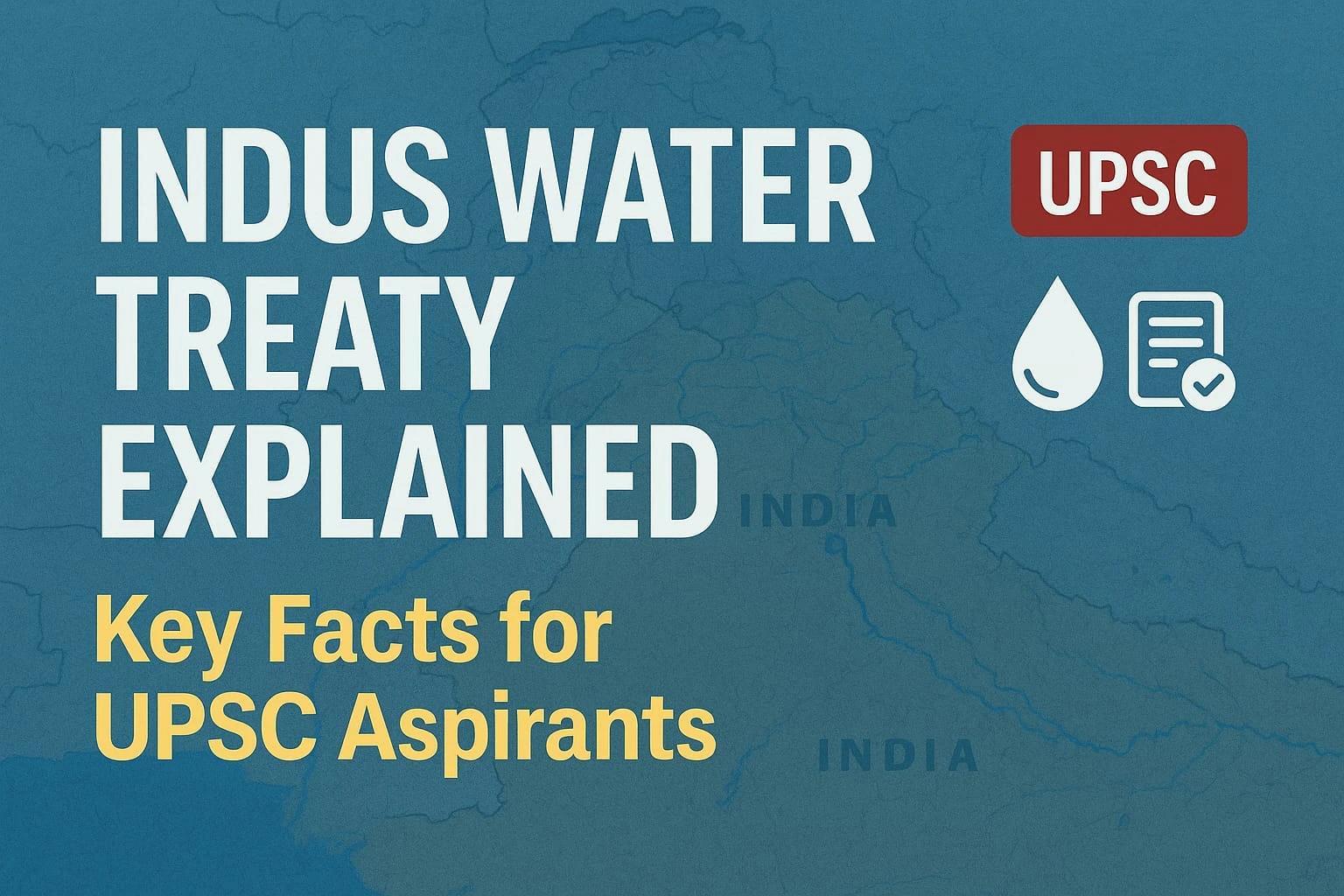When it comes to India-Pakistan relations, few topics hold as much strategic, diplomatic, and environmental importance as the Indus Water Treaty (IWT). For aspirants preparing for UPSC, the Indus Water Treaty UPSC topic is crucial—not only for understanding international water-sharing agreements but also for grasping how such treaties impact geopolitical stability in South Asia.
Signed in 1960 between India and Pakistan, with the World Bank as a mediator, the Indus Water Treaty governs the sharing of the Indus River system, comprising six rivers that are lifelines for millions across both nations. This treaty has stood the test of time, even during full-scale wars, making it a unique example of cooperation amid conflict.
History Of Indus Water Treaty (IWT):-
Post the 1947 partition, the division of the Indus River system became a contentious issue. The headworks of major rivers were in India, while the downstream flow was crucial for Pakistan’s agriculture. After protracted negotiations, the IWT was signed on September 19, 1960, by:
- Jawaharlal Nehru, Prime Minister of India
- Ayub Khan, President of Pakistan
- World Bank, as a signatory and mediator
The treaty delineated the control of six rivers:
- Eastern Rivers: Ravi, Beas, Sutlej – allocated to India
- Western Rivers: Indus, Jhelum, Chenab – allocated to Pakistan
For an in-depth understanding, refer to the World Bank Fact Sheet on the Indus Waters Treaty.
Key Provisions of the Treaty:-
The Indus Water Treaty, signed in 1960 between India and Pakistan, has several key provisions that govern water distribution. It allocates the waters of six rivers—Indus, Jhelum, Chenab for Pakistan, and Ravi, Beas, Sutlej for India.
India retains control over the eastern rivers while Pakistan is granted rights to the western rivers. This division aims to ensure equitable use of shared water resources.
The treaty also establishes a framework for cooperation and conflict resolution. A Permanent Industrial Commission was set up to oversee its implementation.
Regular meetings are held to address disputes or concerns regarding water management. The treaty emphasizes sustainable practices while allowing for hydroelectric projects on both sides.
These provisions create a structured environment where both nations can negotiate their interests peacefully despite ongoing tensions.
The IWT is lauded for its detailed framework, ensuring equitable water distribution:
- India’s Rights:
- Full utilization of Eastern Rivers for consumption, irrigation, and hydropower.
- Non-consumptive use of Western Rivers, including hydropower generation, navigation, and fisheries.
- Pakistan’s Rights:
- Exclusive rights over Western Rivers for agriculture and other needs.
- Permanent Indus Commission (PIC):
- Established for regular data exchange, inspections, and dispute resolution.
Access the official treaty document here: Indus Waters Treaty 1960 PDF.
Significance in India-Pakistan Relations:-
Despite multiple conflicts, including wars in 1965 and 1971, the IWT has remained intact, showcasing its resilience. It serves as a testament to the possibility of cooperation amidst adversities.
The Indus Water Treaty holds immense significance for both India and Pakistan. It established a framework for sharing water resources from the Indus River system, which is vital for agriculture and livelihoods in both nations.
For India, the treaty secures access to eastern rivers—Beas, Ravi, and Sutlej. This is crucial not just for irrigation but also for hydroelectric projects that support energy needs.
On the other hand, Pakistan relies heavily on the western rivers—Indus, Jhelum, and Chenab. The treaty ensures that its agricultural sector can flourish despite regional tensions.
Moreover, it acts as a stabilizing force amid political discord. By fostering cooperation over shared resources, it mitigates potential conflicts stemming from water scarcity.
In an era of climate change impacting river flows significantly, the treaty’s relevance persists as both countries navigate evolving challenges together.
Recent Developments and Challenges:-
In April 2025, following a deadly attack in Kashmir that claimed 26 lives, India suspended the Indus Waters Treaty, citing national security concerns . This unprecedented move has escalated tensions, with Pakistan viewing it as a breach of international obligations. Latest news & breaking headlines
Climate change further exacerbates the situation, with erratic monsoons and glacial melt impacting river flows.
Delve into the intricacies of water security challenges in India: Water Security: Issues and Challenges for India.
Indus Water Treaty UPSC Exam Perspective:-
The Indus Water Treaty holds significant relevance for aspiring UPSC candidates. Understanding its intricacies can enhance one’s grasp of international relations and environmental policies.
This treaty is a prime example of water resource management between India and Pakistan. It offers insights into how geopolitical tensions can influence agreements on shared resources. Candidates should focus on its provisions, implications, and the evolving dynamics surrounding it.
Questions in the exam often test analytical skills related to bilateral relations and their historical context. The treaty serves as a case study that showcases diplomatic negotiations.
Moreover, topics like climate change’s impact on water availability are increasingly relevant. This adds another layer of complexity for candidates to explore during their preparation.
Familiarity with such treaties not only helps in exams but also fosters a deeper understanding of crucial policy issues affecting both nations today.
UPSC 2016 Mains GS1 Model Answer –
Q18. Present an account of the Indus Water Treaty and examine its ecological, economic, and political implications in the context of changing bilateral relations.
The Indus Water Treaty, signed in 1960 between India and Pakistan, allocates the use of river waters from the Indus Basin. It grants control over three eastern rivers—Beas, Ravi, and Sutlej—to India while Pakistan secures rights to the western rivers—Indus, Jhelum, and Chenab.
Ecologically, this treaty plays a vital role in sustaining agricultural practices on both sides. However, changing weather patterns raise concerns about water scarcity.
Economically, it fosters interdependence but also fuels tensions when one nation perceives threats to its water security. Disputes often arise over dam constructions and hydroelectric projects.
Politically, the treaty is a symbol of cooperation, yet remains fragile amid evolving bilateral relations. As mutual distrust persists due to various geopolitical factors, any alteration in compliance can jeopardize not only regional stability but also international diplomatic ties.
Why is the Indus Water Treaty important for UPSC?
The Indus Water Treaty holds significant importance for the UPSC examination, particularly in the realms of international relations, environmental studies, and public policy. As a key diplomatic agreement between India and Pakistan, it offers a rich case study to evaluate complex geopolitical dynamics.
Understanding this treaty can deepen your insights into water resource management issues and transboundary cooperation. The intricate balance of rights and responsibilities established by the treaty reflects broader themes like conflict resolution and sustainable development, key areas that are often explored in various papers.
For aspirants focusing on General Studies or Political Science optional subjects, thorough knowledge of the Indus Water Treaty can provide an edge. It not only illustrates historical context but also helps analyze ongoing regional tensions over water resources amidst climate change concerns.
Moreover, questions related to treaties like this one frequently appear in both prelims and mains exams. Being well-versed with its provisions allows candidates to address current affairs effectively while integrating them into their answers seamlessly.
As you prepare for UPSC exams, recognizing the relevance of such treaties will equip you with valuable perspectives on international diplomacy. Keeping updated about changes surrounding agreements like the Indus Water Treaty is essential for any serious candidate aiming to make sense of India’s bilateral relations within South Asia.
Relevance for UPSC Aspirants
The IWT is pertinent across various segments of the UPSC syllabus:
- GS Paper II: International Relations – India-Pakistan dynamics, treaties, and agreements.
- GS Paper III: Environment – Water resources, climate change impacts.
- Essay Paper: Topics on diplomacy, environmental challenges, and regional cooperation.
- Interview Stage: Discussions on current affairs, international treaties, and conflict resolution.
Enhance your preparation with detailed notes: India-Pakistan Relations Notes for UPSC Exam – theIAShub.
Conclusion:
The Indus Water Treaty stands as a beacon of cooperation in a region fraught with tensions. Its endurance underscores the importance of dialogue and mutual respect in resolving complex issues. However, evolving challenges necessitate adaptive strategies to ensure its continued relevance and effectiveness.
Frequently Asked Questions (FAQs):-
Q1: What is the Indus Water Treaty?
A: The Indus Water Treaty is a water-sharing agreement signed in 1960 between India and Pakistan, facilitated by the World Bank, to allocate the waters of the Indus River system.
Q2: Why is the treaty significant?
A: It has successfully managed water distribution between two rival nations for over six decades, even during periods of conflict.
Q3: Has the treaty ever been suspended?
A: Yes, in April 2025, India suspended the treaty following a terrorist attack in Kashmir, marking a significant shift in bilateral relations.
Q4: How does climate change impact the treaty?
A: Climate change affects river flows through glacial melt and altered monsoon patterns, posing challenges to the treaty’s provisions.
Q5. What is the full form of IWT?
A: IWT – Indus Water Treaty.
Q5: Where can I find the official treaty document?
A: The treaty document is available on the United Nations Treaty Collection: Indus Waters Treaty 1960 PDF.

Automotive industry analyst with 3+ years of experience dissecting market trends, emerging technologies, and consumer insights. His expertise fuels data-driven perspectives on swagatswork.com, empowering professionals to navigate the evolving automotive landscape.

1 thought on “Indus Water Treaty UPSC: Comprehensive Guide for Aspirants for 2025”